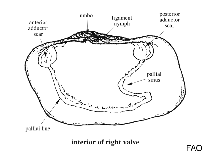Panopea generosa (Gould, 1850)
Pacific geoduck| Native range | All suitable habitat | Point map | Year 2050 |

|
| This map was computer-generated and has not yet been reviewed. |
| Panopea generosa AquaMaps Data sources: GBIF OBIS |
Google image | No image available for this species;
drawing shows typical species in Hiatellidae.
Classification / Names आम नाम | उपशब्द | CoL | ITIS | WoRMS
Bivalvia | Adapedonta | Hiatellidae
Environment: milieu / climate zone / गहराई सीमा / distribution range पारिस्थितिकी
; गहराई सीमा 0 - 110 m (संदर्भ 865). Temperate; 61°N - 26°N, 146°W - 112°W (संदर्भ 104413)
Distribution देश | ऐफ ऐ ओ क्षेत्र | Ecosystems | संयोग | भूमिका
Eastern Pacific: From Alaska to Baja California. Subtropical to temperate.
Length at first maturity / आकार / Weight / Age
परिपक्व अवधि: Lm ? range ? - ? cm Max length : 17.5 cm SHL पुल्लिंग / अलिंग; (संदर्भ 865); अधिकतम सूचित उम्र: 100 वर्षो (संदर्भ 8702)
Life cycle and mating behavior परिपक्व अवधि | पुनरुत्पत्ति | मछलीऔ का अंडे देना | Eggs | Fecundity | Larvae
Main reference
संदर्भ | संयोजक | सहयोगीयो
Pacific Northwest Shell Club 2014 Pacific Northwest marine molluscan biodiversity. Pacific Northwest Shell Club, www.PNWCS.org. http://www.bily.com/pnwsc/web-content/Northwest%20Marine%20Molluscan%20Biodiversity.html [Accessed 06/02/2014]. (संदर्भ 94906)
IUCN Red List Status
(संदर्भ 130435: Version 2025-1)
CITES status (संदर्भ 108899)
CMS (संदर्भ 116361)
Threat to humans
Human uses
मात्स्यिकी: व्यापारिक
| FishSource |
साधन
अधिक जानकारी
इंटरनेट स्रोत
BHL | BOLD Systems | CISTI | DiscoverLife | FAO(Publication : search) | Fishipedia | GenBank (genome, nucleotide) | GloBI | Gomexsi | Google Books | Google Scholar | Google | PubMed | Tree of Life | Wikipedia (Go, खोज) | Zoological Record



